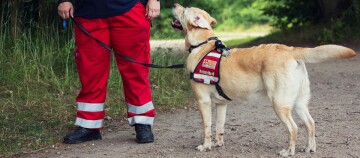Bite Inhibition Training – What Objects They Can Chew and Bite
07.10.2022 - Reading time: 5 minutes

Bite inhibition is in no way an innate skill, but it can be taught to puppies between approximately 4 and 16 weeks of age. The puppies normally learn how to soften their bites – in other words, to control the force of their bites – by playing with their siblings. As they play, they nip and bite each other and if someone bites down too hard, then they will be bitten back hard or punished at the end of the game. The mother will also tell the puppies if they’re going to far by turning away or reprimanding them. By doing this, the young dogs learn how to manage the force of their bites.
Why is it important to learn bite inhibition?
Alongside humans puppies must also learn when their bite is too strong since they can cause serious damage to people and especially children with their bites. The puppies must, therefore, use soft bites with humans and other dogs, which is also known as “soft mouth”. In practice this means that the owner must let the puppies know where the limits lie so that they learn what humans’ pain tolerances are when playing.
If the puppies don’t learn how to inhibit their bites in the above-mentioned time period, it is very difficult and time consuming to teach them later. So that they optimally develop their bite inhibitions, it’s important that they have regular contact to other dogs, for example, at obedience school, and that their owner trains with them. In this case, training doesn’t only mean learning how to control the force of their bite, but also teaching the puppies what they can chew and bite on and which objects and body parts are no-nos.
Tips on training your puppy to inhibit bites
In order to show your dog that they went too far during a game and bit down too hard, you should end playtime immediately and leave the room. By doing so you teach your puppy that fun time is over when they use their teeth. For those who are slow to learn, you can also take them by their nose and mouth, ideally with a signal word. If your dog bites, hold them and say something at the same time, for example “No”. This is something that the mothers of puppies will also do if they cross a line. After repeating this nose hold several times with the signal word, your dog should understand that they have displayed unwanted behaviour and then in the future you should be able to use the signal word alone to train them.
Ensuring bite inhibition around children
Especially in families with children, is it essential that the dog learns and has good bite inhibition around children so as not to injure them. As a dog owner, this is not a particularly easy task since dogs don’t see children as equals to them until they are approximately seven years old, considering them to be puppies until this point and will treat them as such within the pack. For this reason, interactions between dogs and smaller children require constant supervision and anything over the line must be stopped immediately. This applies to both dogs and the child. It is also a good idea to let the dogs get used to allowing children to stroke their nose, ears and tail.
As a rule: dogs don’t bite without a reason! Therefore, it’s imperative to carefully watch the dog as well as your own behaviour to ensure harmonious co-existence between dog and human.
Bite inhibition exercises for dogs and children
Let your dog get used to being stroked on the nose, ears and tail. When they allow you to touch them in this way, you can then practise stroking them with your child. Teach your child not to be overly energetic with the dog, rather that they should go slow and not be too rough when playing. Otherwise there’s an increased risk that the dog will defend itself by biting, or try to teach the children by doing so. As a rule, bite inhibition training should be carried out only by adults as dogs don’t see children in the same way as adults.
Biting because of stress and fear
Many dogs react to stress with fear and, as a last resort, display this by biting. The stress may be caused by a stranger touching or petting the dog on their head, or by unfamiliar situations such as being amongst a large group of people. When they occur, you need to identify what is causing the stress, defuse the situation and train the dog in a targeted manner to desensitise them. In this way, your dog learns how to better deal with such situations.
If your dog bites due to stress, you should also ensure that they have a quiet place they can retreat to and a place to eat where they won’t be disturbed. With such dogs, it is especially important to get help from a professional and train them regularly.
Biting to climb the ranks
When dogs cross the line in a pack, it is quickly sorted out with a bite and rank is restored. The same applies to a dog’s rank in a family of humans: your dog should always know their place and what rules apply to them. This requires there to be a known authority, which is completely natural for a dog. If everyone has their assigned place within a family and strict limits and allowances are part of daily life, your dog will not try to climb the rank ladder. If you give them leeway above their rank, they will try to improve their status in the hierarchy by biting.
If your dog carries on biting despite the training, then we would advise seeking an animal trainer.



